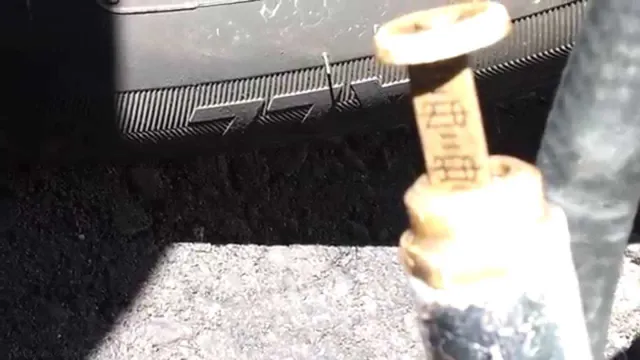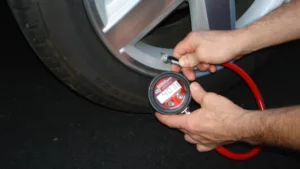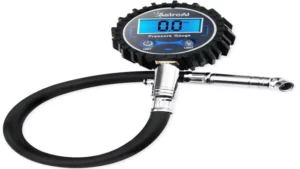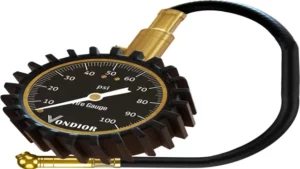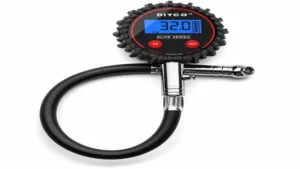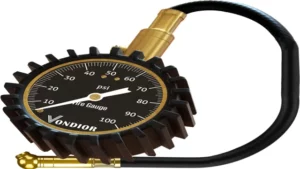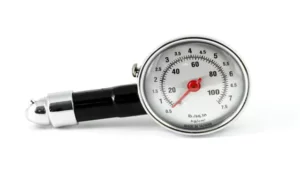Have you ever pulled up to a gas station and found yourself at a loss for how to use the tire pressure gauge? You’re not alone. It can be confusing to figure out the numbers and markings on that little device, but it’s important to regularly check your tire pressure to ensure a safe and fuel-efficient ride. In this blog, we’re going to break down the steps to using a gas station tire pressure gauge, so you can have peace of mind knowing your tires are in good shape.
Think of it as a mini lesson that will have you feeling confident in no time. So, let’s get started!
Why It’s Important to Check Your Tire Pressure Regularly
If you’re someone who’s not too familiar with how to read a gas station tire pressure gauge, you’re not alone. It can be a little confusing at first, but it’s an important skill to learn if you want to ensure your tires are safe and properly inflated. Checking your tire pressure regularly is crucial because properly inflated tires can improve your car’s handling and fuel efficiency, while also reducing the risk of a blowout or other tire-related issues.
When using a gas station tire pressure gauge, simply remove the cap from your tire’s valve stem and press the gauge onto the stem firmly enough that you hear a hissing sound. The gauge will then show you the PSI (pounds per square inch) reading of your tire’s pressure, which should match the recommended PSI listed in your car’s owner’s manual. By checking your tire pressure regularly and using a gas station tire pressure gauge, you can stay safe on the road and potentially save money on fuel costs in the long run.
Extend the Lifespan of Your Tires
Maintaining proper tire pressure is crucial for extending the lifespan of your tires. Many people overlook the importance of checking their tire pressure regularly, which can result in reduced tire performance, decreased fuel efficiency, and even accidents. Tire pressure affects your vehicle’s stability, braking, handling, and cornering, so it’s essential to keep it at the manufacturer’s recommended levels.
Low tire pressure causes more tire wear, raises your risk of hydroplaning, and increases your chances of getting a flat tire. So, make sure to check your tire pressure at least once a month and before long journeys. Don’t forget that cold weather can affect your tire pressure, so keep that in mind when checking it during winter months.
Proper tire maintenance can save you money, reduce your carbon footprint, and ensure a safe driving experience. Remember, a well-maintained tire is a happy tire!
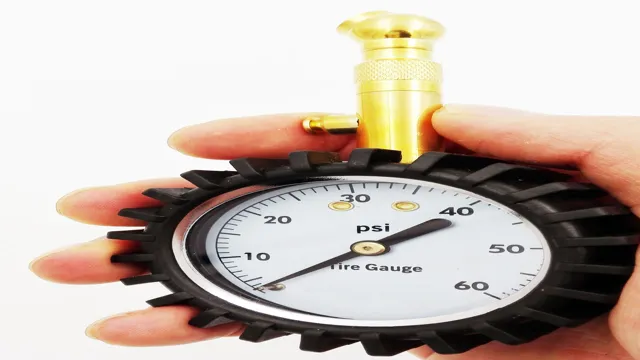
Improved Gas Mileage
Checking your tire pressure regularly can significantly improve your gas mileage. Underinflated tires cause increased resistance, which means your car has to use more fuel to move forward. This resistance also causes your tires to wear down much faster, leading to costly replacements.
By keeping your tire pressure at the recommended level, you can improve your fuel efficiency by up to 3 percent. That may not seem like much, but over time, it can make a significant difference in your wallet and the environment. Plus, ensuring that your tires are properly inflated can also improve your car’s handling and safety on the road.
So, don’t forget to check your tire pressure at least once a month and before any long road trips. Your wallet and the planet will thank you!
Locating and Using the Gas Station Tire Pressure Gauge
Learning how to read a gas station tire pressure gauge is essential for every driver. It’s common knowledge that maintaining the proper tire pressure is crucial for ensuring a safe and comfortable ride. You can easily find a tire pressure gauge at most gas stations, and they’re usually located near the air pump.
To use the gauge, simply unscrew the valve stem cap and press the gauge firmly onto the stem. You’ll see a digital or analog reading of the tire pressure in PSI (pounds per square inch). Make sure the gauge is properly calibrated to avoid incorrect readings.
If the pressure is too low, use the air pump to inflate the tire to the recommended pressure, indicated in your car’s owner’s manual or on the tire’s sidewall. If the pressure is too high, you’ll need to release some air by pressing the pin inside the valve stem with a small tool like a pen cap or a screwdriver. Repeat the process for all four tires, and you’re good to go.
Regularly checking your tire pressure is a small but important step to ensure your safety on the road.
Locating the Gauge on the Air Pump
Locating and using the gas station tire pressure gauge might seem a little daunting at first, but it’s actually quite simple. First off, locate the air pump at the gas station. Then, find the gauge that’s usually attached to the air hose.
It might be closer to the ground or on top of the air pump, depending on the station. The gauge will have a display that shows the current pressure of your tires in PSI. Once you’ve located the gauge, it’s time to use it.
Remove the valve cap from your tire and attach the gauge securely onto the valve stem. Push the gauge in firmly until you hear a hiss of air. The gauge will then display the current pressure of your tire.
Finally, if the pressure is too low, inflate the tire with the air pump and check the pressure again using the gauge. With a little practice, you’ll be a pro in no time.
Using the Pressure Gauge Correctly
When it comes to maintaining the health of your vehicle, tire pressure is a vital aspect that can significantly affect your car’s handling, performance, and overall safety. Therefore, having a reliable tire pressure gauge is crucial for every car owner. Typically, you can find a tire pressure gauge located at a gas station’s air pump station.
When using a pressure gauge, it is essential to first ensure that the gauge reading is zero before attaching it to the tire valve stem. To get the most accurate reading, make sure that your tire hasn’t been recently driven, and the tire pressure is in the recommended range for your vehicle, which you can find in the owner’s manual or the car’s door jamb. A tire pressure gauge is a simple tool that can help extend the life of your tires and keep you safe on the road.
By regularly checking your tire pressure and maintaining it at the recommended level, you can avoid costly car repairs and ensure that your driving experience is always smooth and secure.
Example of Reading the Gauge
gas station tire pressure gauge If you’re looking to locate and use the gas station tire pressure gauge, you’re in luck because it’s usually located near the air pump. But how do you use it? First, unscrew the cap on the valve stem of your tire and press the gauge onto the stem. You’ll hear a little hiss of air as the gauge takes a reading.
The gauge will show you the pressure in psi (pounds per square inch). Compare this reading to your vehicle manufacturer’s recommended tire pressure, which can usually be found on a sticker inside the driver’s side door or in the owner’s manual. If the reading is too low, add air using the air pump and recheck the pressure with the gauge.
If it’s too high, release air by pressing the small stem in the center of the valve stem with the gauge until you reach the recommended pressure. Remember, maintaining the correct tire pressure helps improve fuel efficiency and extend the life of your tires, so make it a habit to check often using the gas station tire pressure gauge.
Tips for Maintaining Adequate Tire Pressure
Maintaining optimal tire pressure is essential for ensuring safe and smooth driving. One way to ensure you have adequate tire pressure is by using a gas station tire pressure gauge. However, if you’re unsure how to read it, it can be daunting.
Fortunately, it’s easy once you understand the basics. First, remove the cap from the tire valve stem, then press the tire pressure gauge onto the stem. The gauge will display the pressure in PSI (pounds per square inch).
If the reading is too high or low, use the air compressor to adjust the pressure accordingly. It’s essential to check your tire pressure regularly, as it decreases over time, especially during temperature changes. Driving with underinflated or overinflated tires can also lead to premature tire wear, poor fuel economy, and a higher risk of accidents.
By mastering the art of reading the gas station tire pressure gauge, you can ensure your tires always have optimal pressure and help keep yourself and others safe on the road.
Check Tire Pressure Once a Month
Maintaining adequate tire pressure is important for both your vehicle’s safety and performance. Checking your tire pressure should be a monthly task to ensure your tires are not over or underinflated. Driving with underinflated tires can cause excessive wear, reduce fuel efficiency, and increase the risk of a blowout.
Overinflated tires can also negatively impact your vehicle’s handling and reduce the lifespan of the tire. To maintain your tire pressure properly, use a tire pressure gauge and fill your tires to the recommended level listed in your vehicle owner’s manual. It’s also essential to keep an eye out for any tire punctures or leaks that could lead to rapid deflation, which can put you and your passengers at risk.
By following these simple steps, you can help ensure that your tires are in good condition and perform well for miles to come.
Compare Tire Pressure to Manufacturer Recommendations
One of the most important things you can do to maintain your vehicle’s safety and performance is to keep your tires properly inflated. Checking tire pressure regularly is a simple task that can be done in just a few minutes, but it can have a big impact on your car’s handling and fuel efficiency. To make sure you are maintaining adequate tire pressure, it’s important to compare the pressure to the manufacturer’s recommendations, which can usually be found in your vehicle’s owner’s manual or on a sticker inside the driver’s side door.
It’s essential to follow these guidelines, as underinflated tires can lead to decreased fuel efficiency and poor handling, while overinflated tires can cause premature wear and tear, as well as worsened traction. Additionally, always consider the environment in which you are driving and adjust your tire pressure accordingly. For instance, if you’re driving in the winter, it may be necessary to slightly decrease your tire pressure to give your tires more surface area and improve traction on slippery roads.
Proper tire pressure not only keeps you safe on the road but can also save you money on fuel costs and tire replacement in the long run.
Conclusion
In conclusion, reading a gas station tire pressure gauge may seem daunting at first, but just like learning to ride a bike or mastering a new recipe, it takes practice and patience. So, take a deep breath, put on your reading glasses if needed, and remember to double-check before adding or releasing any air. And who knows, maybe one day you’ll be able to impress your friends with your tire pressure reading skills – now that’s a gauge of success!”
FAQs
What is a gas station tire pressure gauge?
A gas station tire pressure gauge is a tool available at gas stations that allows you to check the air pressure of your vehicle’s tires.
How do you use a gas station tire pressure gauge?
To use a gas station tire pressure gauge, first, remove the valve cap on your tire. Next, press the gauge onto the valve stem firmly until you hear a sound of escaping air. Read the pressure measurement on the gauge and compare it to the recommended air pressure for your tire as specified in your vehicle’s owner’s manual or inside the driver’s side door.
Can gas station tire pressure gauges be inaccurate?
Yes, gas station tire pressure gauges can be inaccurate due to different reasons such as improper maintenance and calibration. It is always a good practice to compare the readings from different gauges and invest in a good quality gauge for more accurate readings.
What is the recommended tire pressure for most vehicles?
The recommended tire pressure for most vehicles is typically between 30-35 psi. However, the specific recommended tire pressure for your vehicle may vary depending on the make and model.
How often should you check your tire pressure?
It is recommended to check your tire pressure at least once a month, or before heading on a long road trip. Tire pressure can also change due to temperature differences, so it’s a good practice to check your tire pressure more frequently during extreme weather conditions.
What are the consequences of driving with low tire pressure?
Driving with low tire pressure can lead to reduced fuel efficiency, uneven tire wear, and decreased driving performance and safety. It can also lead to overheating and ultimately, tire failure.
How do you add air to your tires?
To add air to your tires, use the gas station air compressor, set it to the correct pressure, and attach the air hose to your tire’s valve stem. Press the lever to inflate the tire to the desired pressure, and stop periodically to check the pressure with a gauge to avoid overinflating the tire.
